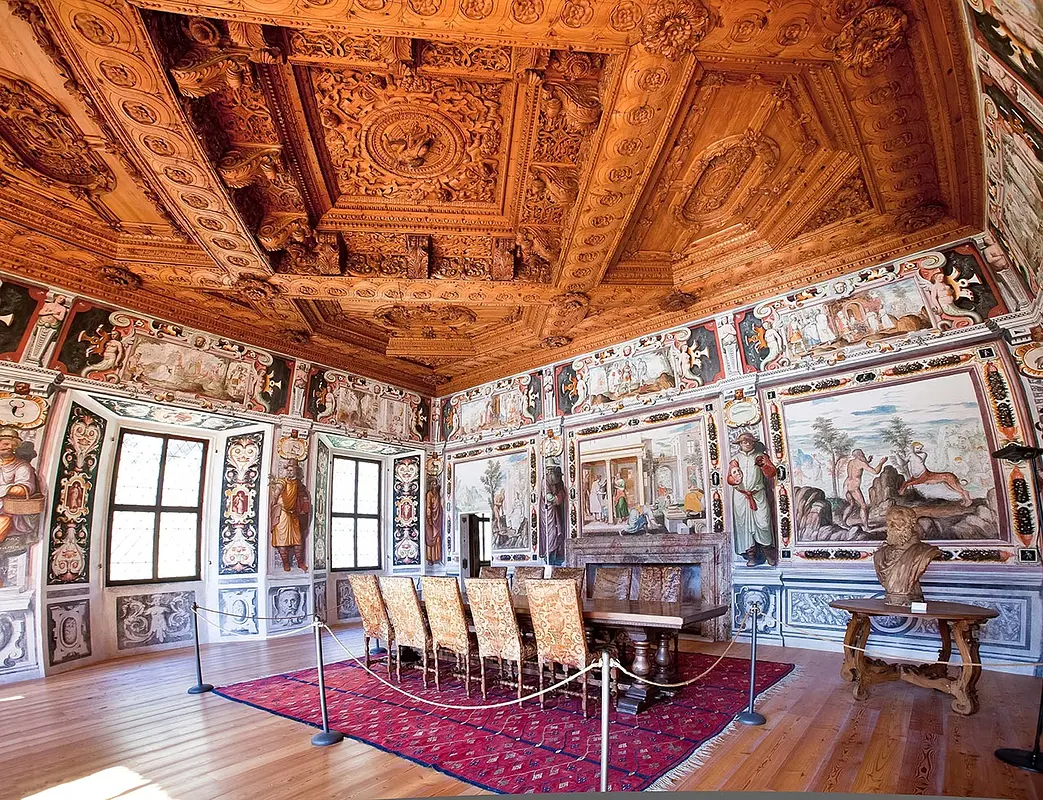










Vertemate Franks Palace
A treasure chest of arts and crafts restored to life



Where

What it is and where it is
A boundary wall, interrupted by an arched doorway surmounted by a gable. Behind it, a country house strengthened by buttresses, white walls, plain. At first glance it appears to be an elegant, sober house , certainly of a wealthy family. There is, however, something atypical, a little quirk, a clue: the doors. Made of wood, open on the many windows that populate the facade, they are decorated with carvings. It is a geometric pattern that is not too elaborate, but its repetition seems to want to warn us that we should not trust our first impression.
Why it is special
The sashes were right. As soon as we enter we are enveloped in a decorative rush interrupted only by the physical limit of the surfaces. Yes, surfaces, not walls, because in Palazzo Vertemate Franchi everything is decorated. Frescoes, paintings, woodwork and majestically carved ceilings, stoves with finely crafted ceramics, everything is a hymn to beauty, everything has a story to tell. Even the windows give no respite: each one is a view of the Alps, or of the Italian garden, geometric, harmonious, or even of the villa's crops. Here, everything has become art, to inebriate and make one feel full of life.
Not to be missed
Palazzo Vertemate Franchi has been restored according to an interesting project, "Palazzo Vertemate in Valchiavenna: workshop of arts and crafts." Attention not only to the arts, but also to the crafts that were practiced in the country house. Archives preserved here have enabled a philological-botanical and aesthetic reconstruction of what were the garden crops in the 16th century. No tomatoes and potatoes, but plants that predate the spread of American species. The rustic rooms have also been restored and are now usable: the janitor's house, the wine press and the icehouse. Everything has been returned to us, albeit in a new light.
A bit of history
There is no certain information about the construction and decoration work. An inscription on the portal tells us that it was two Vertemate brothers who wanted it built. In one of the rooms is engraved a date, 1577, a sign that the structure already existed at that time. Otherwise, we can only speculate. The official documents were in fact destroyed in the great landslide of 1618. It is the palace itself that tells us this, with two paintings of the village of Piuro: one pre 1618, depicts it in all its beauty. The other, testifies to the devastating effects of the landslide that swept it away. The villa was saved because it was in a somewhat displaced position.
Trivia
The Zodiac Hall represents the signs of the zodiac and with them the succession of months. Each of them thus corresponds to the depiction of the trades that were practiced at that time. The rich decoration and the testimony to rural life that it bears caused this room of the Palazzo Vertemate Franchi to be chosen to represent Italy in the Great Universal Exposition of 1906. To do so, a faithful reproduction was made, which was then also reused in Rome for the celebrations of the 50th anniversary of the Unification of Italy.
Enter the Map of Italy's Undiscovered Wonders and find treasures where you least expect it... Inspire, Recommend, Share...
Collections
The Map thanks:
In the Community
Enter the Map of Italy's Undiscovered Wonders and find treasures where you least expect it... Inspire, Recommend, Share...
Where

Collections

